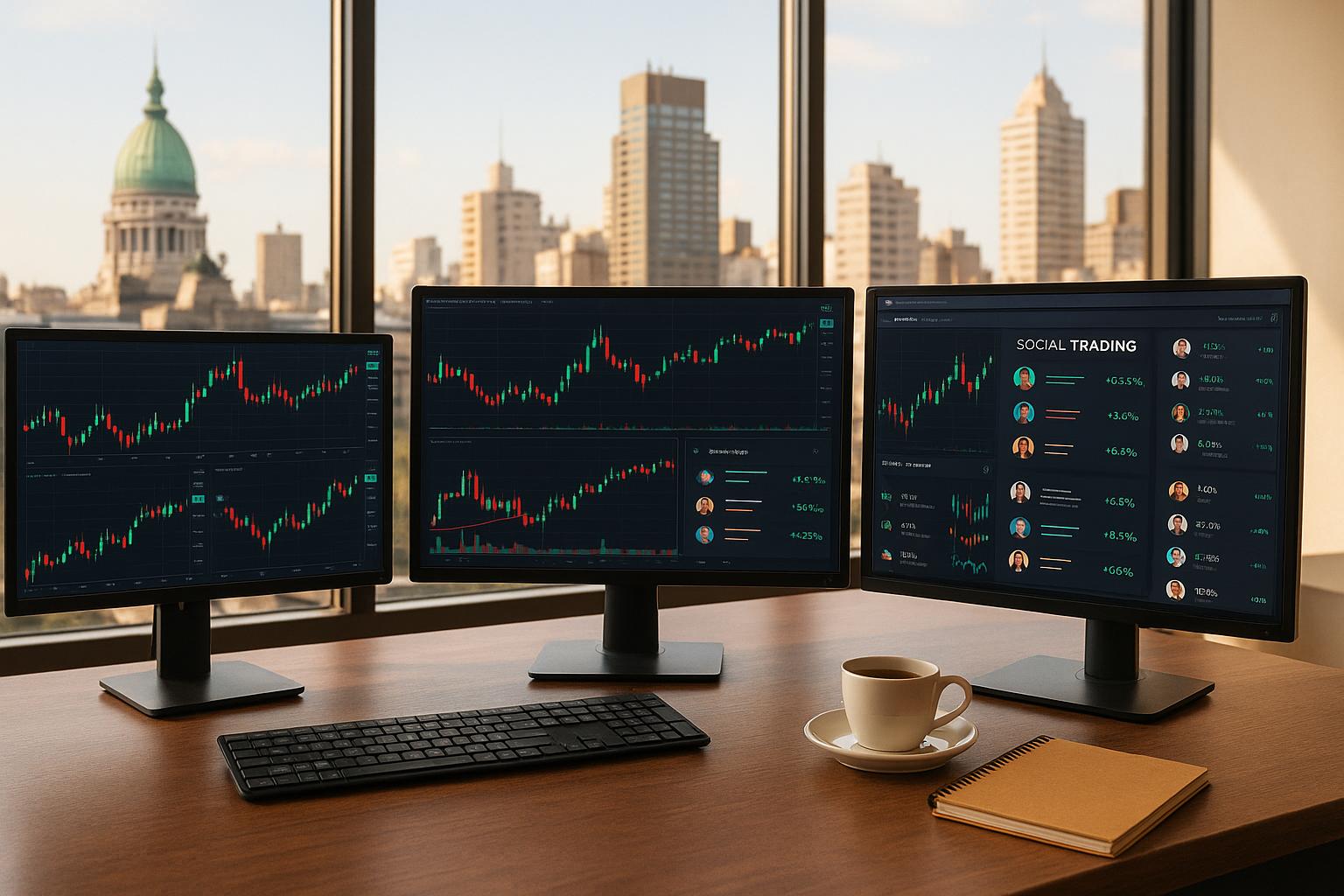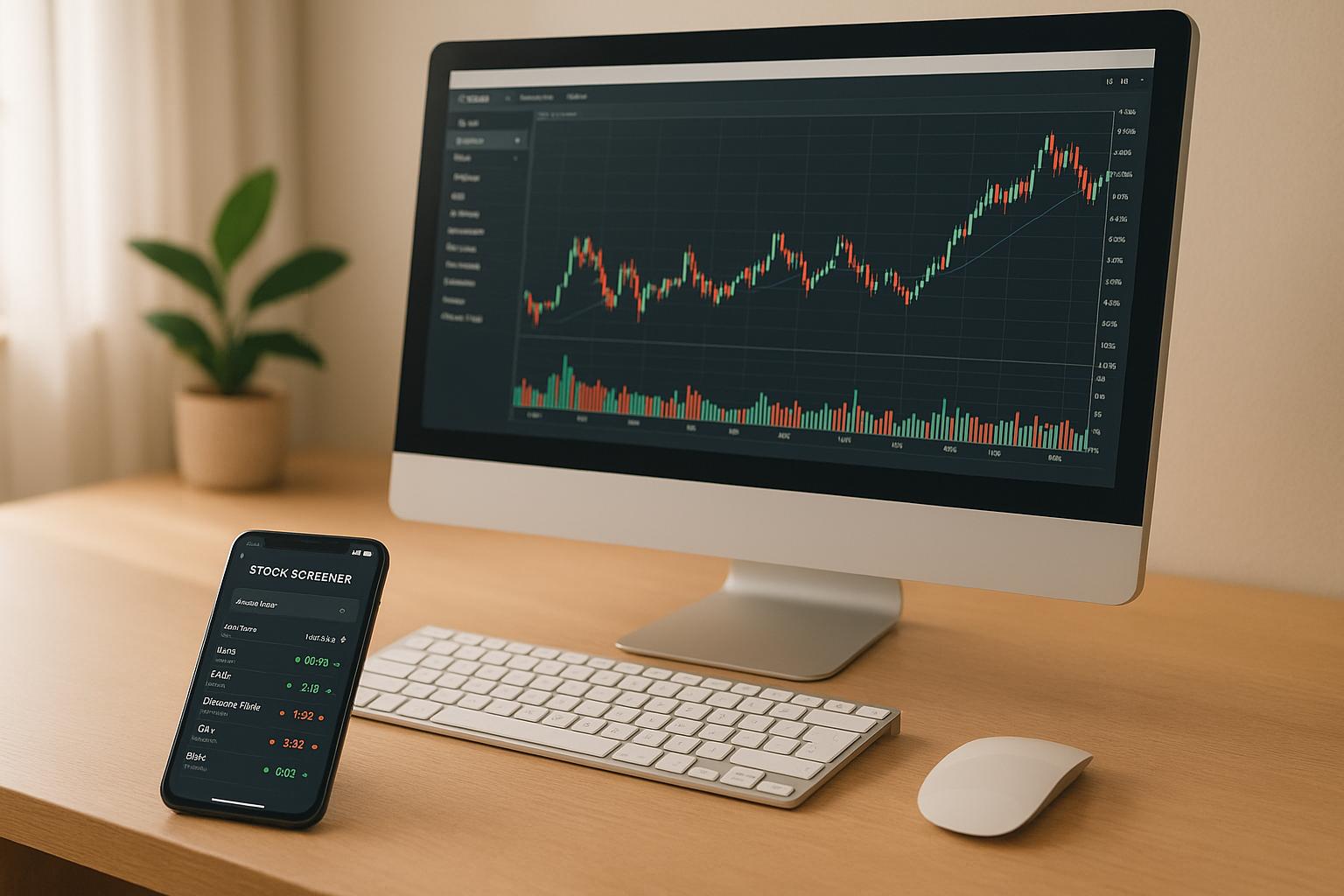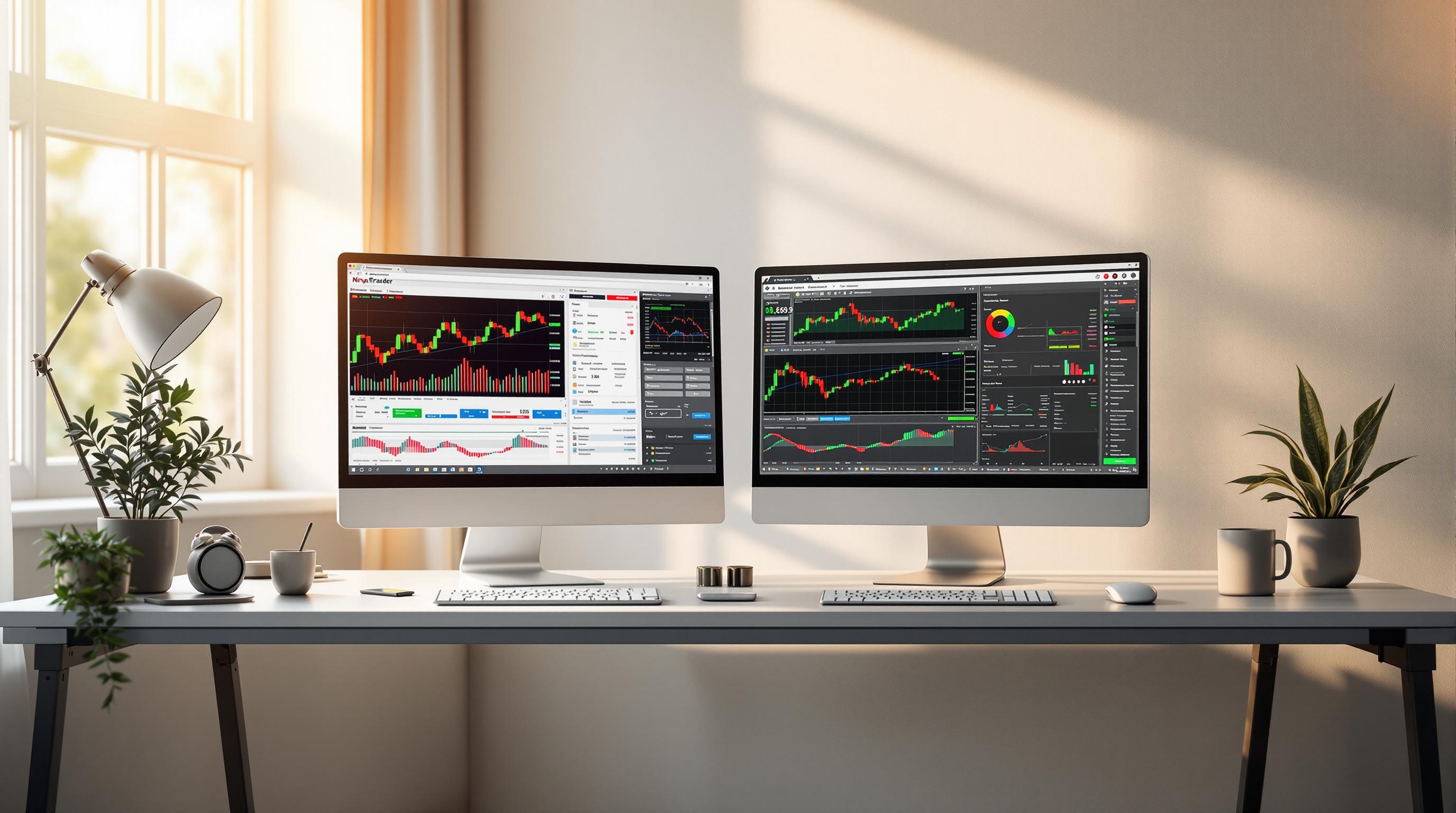If you're looking for platforms to track real-time volatility data, here's what you need to know upfront:
- CME Group CVOL: Ideal for institutional traders, providing 15-second updates on futures across major asset classes. Offers multiple delivery options like APIs and Google Cloud Pub/Sub.
- FinPricing: Covers global markets with real-time FX volatility surfaces and treasury benchmarks. Accessible via API, Excel, or REST.
- OptionMetrics (IvyDB): Focuses on historical options data for academic research and strategy testing. Updates daily.
- Trading Volatility: Specializes in advanced analytics like Gamma Exposure and Skew data, with real-time API feeds.
- IVOlatility: Offers real-time updates on options, futures, and fixed income data through a WebSocket API.
Each platform caters to specific user needs, from institutional-grade tools to advanced analytics for individual traders. Below is a quick comparison to help you decide.
How Market Volatility 📈 Changes the Data You Need
Quick Comparison
| Platform | Data Latency | Asset Coverage | Delivery Methods | Cost Structure |
|---|---|---|---|---|
| CME Group CVOL | 15-second updates | Futures across major asset classes | CME Direct, DataMine, API | Contact for pricing |
| FinPricing | Real-time | FX, fixed income, commodities | API, Excel, REST | Upon request |
| OptionMetrics | Daily updates | Historical options (65 countries) | Data feeds | Higher cost for smaller users |
| Trading Volatility | Real-time | Equity options, advanced analytics | API, WebSocket | Flexible (monthly/yearly) |
| IVOlatility | Real-time | Options, futures, fixed income | WebSocket API | Contact for pricing |
Choosing the right platform depends on your trading goals, data needs, and budget. Keep reading for detailed insights into each platform's features and capabilities.
1. CME Group CVOL
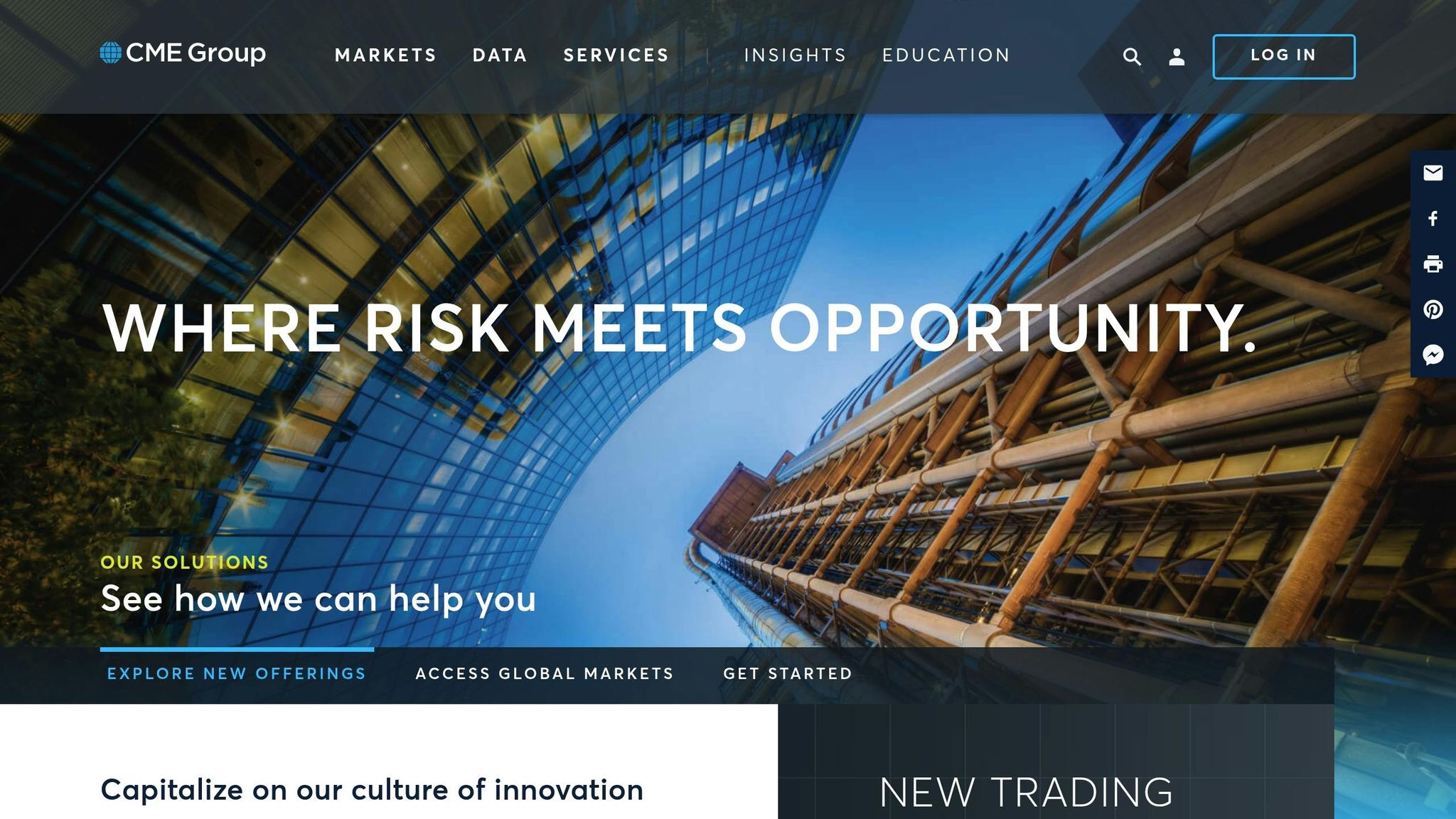
CME Group's CVOL (Chicago Volatility) platform is designed for institutional traders and risk managers who need real-time volatility data across various asset classes. By offering real-time streaming data alongside end-of-day benchmark indices, CVOL ensures consistent variance methodology, making it easier to compare data across different markets and products.
Asset Coverage
CVOL stands out with its coverage of 32 products across five major asset classes: foreign exchange, interest rates, energy, metals, and agriculture. Additionally, it includes six broad-based market indexes that provide cross-asset commodity exposure. This extensive range is particularly helpful for portfolio managers overseeing diverse investments.
One highlight is the Treasury Yield Volatility Index (TVL), which has gained popularity among fixed-income professionals. Many risk managers value TVL for its reliable volatility measures, with some even replacing their internal models due to the high costs and inconsistencies of proprietary calculations. The platform's data delivery capabilities further enhance its utility.
Data Latency
Fast data delivery is critical in volatile markets, and CME Group meets this need with 15-second update intervals for real-time CVOL feeds. This low latency is achieved through the Market Data Platform (MDP), which uses a dual-feed UDP multicast architecture. This setup ensures efficient, scalable message delivery, keeping traders informed in rapidly changing markets.
Delivery Methods
CME Group provides multiple access options to fit different user needs. For analytics, traders can use CME Direct to download CVOL trading grids. For historical data, CME DataMine offers up to nine years of records via REST API, Amazon S3 Transfer, SFTP, or email.
The Market Data Platform (MDP) supports direct API access with data available in SBE and JSON formats. For real-time updates, Google Cloud Pub/Sub enables high-throughput, event-driven applications. This flexibility allows traders to seamlessly integrate TVL data into their systems, making it easier to price options strategies.
"CVOL indices, including TVL, can be accessed in four ways depending on user needs: web-based visualization, daily file delivery via CME DataMine, CME Direct and real-time updates via Google Cloud Pub/Sub." - Eric Leininger, Executive Director of Research and New Product Development for Interest Rates and Equities, CME Group
Cost Structure
CME Group uses a tiered subscription model for CVOL, though specific pricing isn't publicly disclosed. Typically, asset managers subscribe to end-of-day files via DataMine for tasks like portfolio monitoring and client presentations. On the other hand, active traders who need real-time data often choose the more comprehensive MDP access. Firms already connected to CME's trading systems through CME Globex can reduce infrastructure costs by leveraging their existing connectivity.
2. FinPricing
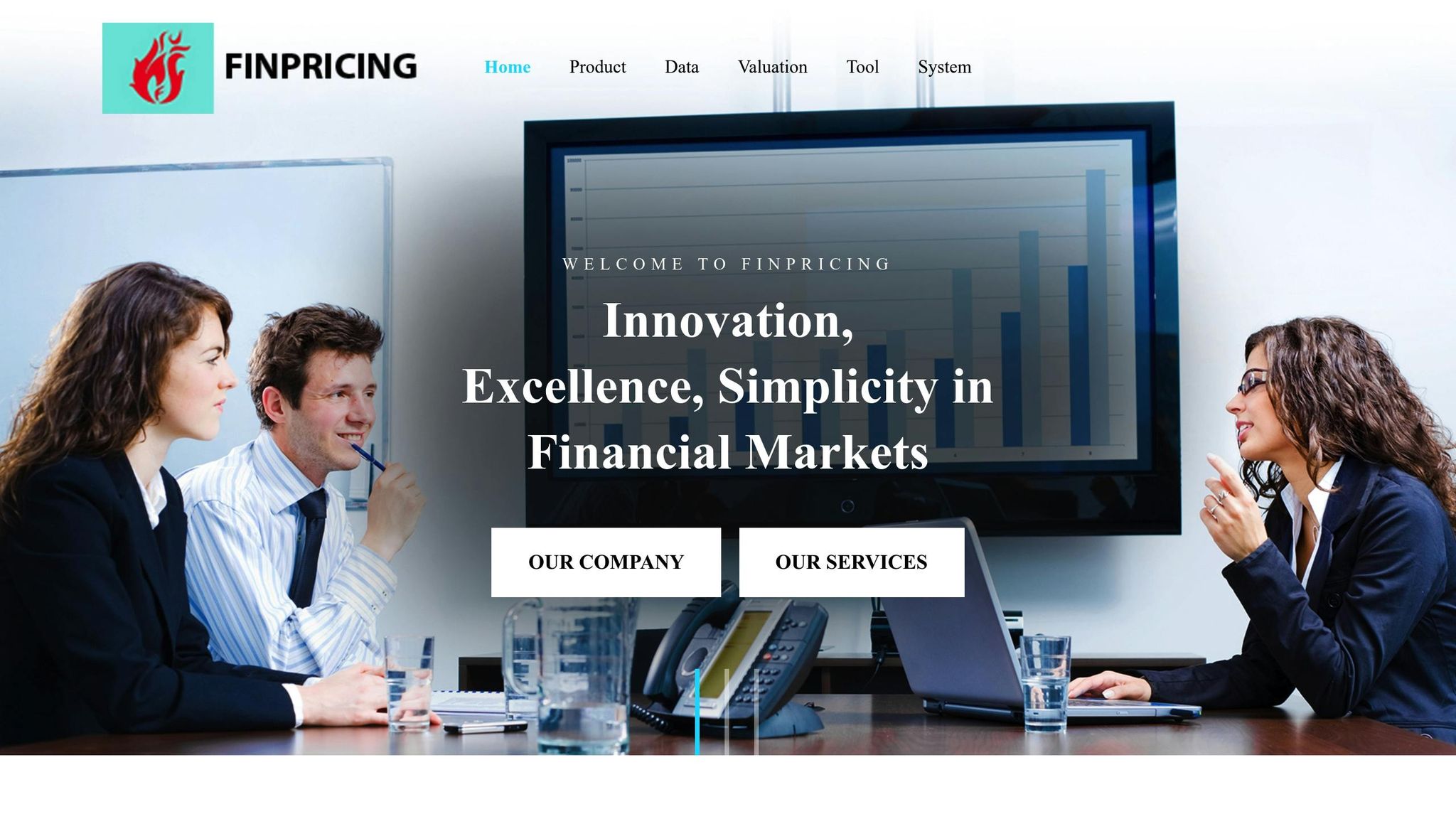
FinPricing, following CME Group's specialized approach, provides a comprehensive view of global volatility data. This platform offers real-time insights across international markets, catering to both traders and risk managers. With coverage spanning 240 countries, it specializes in FX implied volatility surfaces for a wide range of currency pairs. The platform also includes detailed fixed income analytics, such as treasury benchmarks and swaption surfaces, making it a versatile tool for financial professionals.
Asset Coverage
FinPricing supports six key asset classes: interest rates, fixed income, forex, commodities, credit, and equities. One of its standout offerings is the FX Implied Volatility Surface Data, which covers currency pairs from 240 countries. This data includes detailed volatility surfaces featuring at-the-money (ATM), risk reversal, and butterfly spreads at both 10- and 25-delta levels, with maturities extending up to 10 years. The platform's broad asset coverage is complemented by flexible delivery options, enabling seamless real-time analysis.
Delivery Methods
FinPricing's data is accessible through Excel, API, or REST interfaces, ensuring users can choose the method that best fits their workflow. The platform aggregates data from brokers, exchanges, and dealers, delivering reliable and accurate information for real-time decision-making.
Cost Structure
FinPricing follows a yearly licensing model, with pricing details available upon request. This approach allows clients to customize packages based on their specific asset class requirements and preferred data delivery methods. Additionally, free data samples are offered, giving potential customers a chance to assess the quality of the data before committing to a full subscription. While the yearly model is ideal for institutional clients who need consistent access to volatility data throughout trading cycles, it may require a higher upfront investment compared to monthly subscription options.
3. OptionMetrics (IvyDB)
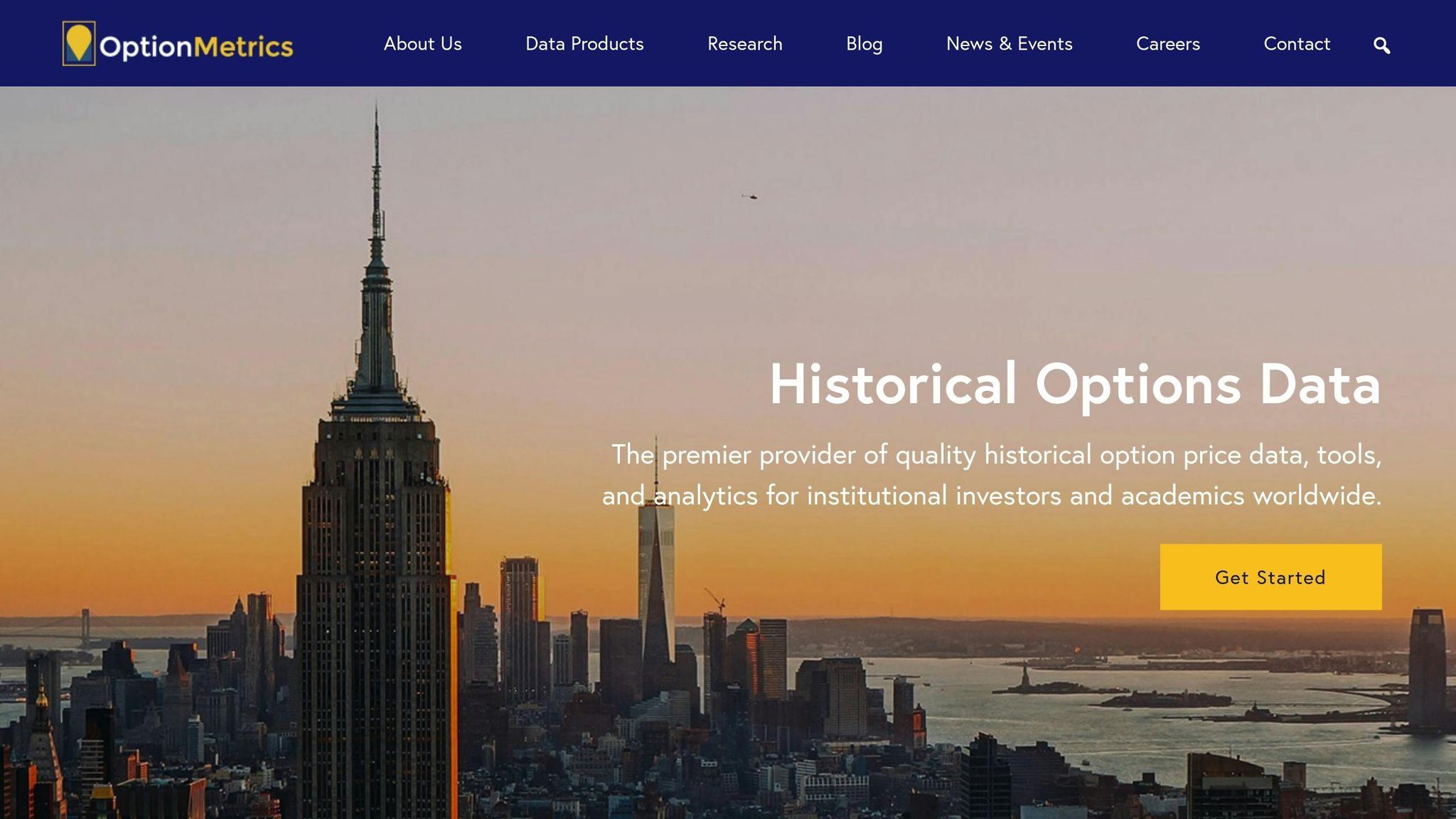
OptionMetrics delivers historical options data through its IvyDB series, serving over 350 institutions worldwide. While its primary focus is on historical data, the platform’s broad coverage and daily updates make it a go-to resource for volatility analysis and research. It’s particularly popular among institutional investors, risk managers, and academic researchers who rely on detailed options pricing and implied volatility data to evaluate models and test strategies. Although real-time data isn't its specialty, OptionMetrics' extensive historical databases and consistent updates complement platforms that focus on live metrics.
Asset Coverage
OptionMetrics provides global coverage through its suite of specialized databases. The flagship IvyDB US database includes historical data for all U.S. exchange-traded equity and index options, along with ETFs and ADRs, dating back to January 1996. Similarly, IvyDB Europe covers over 900 optionable securities from major exchanges in countries like the UK, France, Germany, and more, with data starting from January 2002.
For the Asia-Pacific region, IvyDB Asia-Pacific tracks more than 600 optionable securities from key exchanges, offering robust regional data.
In December 2024, the platform expanded further with IvyDB Futures 3.0, which includes data on 100+ of the most liquid optionable futures from CME, ICE, and Eurex. This database spans eight sectors and features 30+ U.S. futures from CME and 70+ European futures from ICE and Eurex. U.S. futures options data dates back to January 2005, while European data begins from October 2020.
Additionally, the IvyDB ETF database focuses on over 3,000 U.S.-listed ETFs, offering historical option pricing and implied volatility data specifically for ETFs. This emphasis on historical data makes OptionMetrics especially suited for long-term strategy testing rather than immediate trading decisions.
Data Latency
OptionMetrics updates its IvyDB US database daily, ensuring fresh data is available after each trading day. To maintain accuracy, the platform also provides daily patch files to correct any previous data errors, a feature that enhances reliability for users who depend on precise historical records.
Delivery Methods
The platform offers user-friendly data delivery options designed to support activities like risk model evaluation, academic research, and strategy testing. Alongside these services, OptionMetrics provides detailed support materials and customer service during Eastern Time business hours. For urgent issues, 24/7 assistance is also available.
Cost Structure
OptionMetrics is tailored for institutional clients, including corporate and academic organizations, rather than individual retail investors. Pricing is customized based on the institution’s specific needs and the database access required, reflecting its focus on enterprise-level solutions.
sbb-itb-2e26d5a
4. Trading Volatility
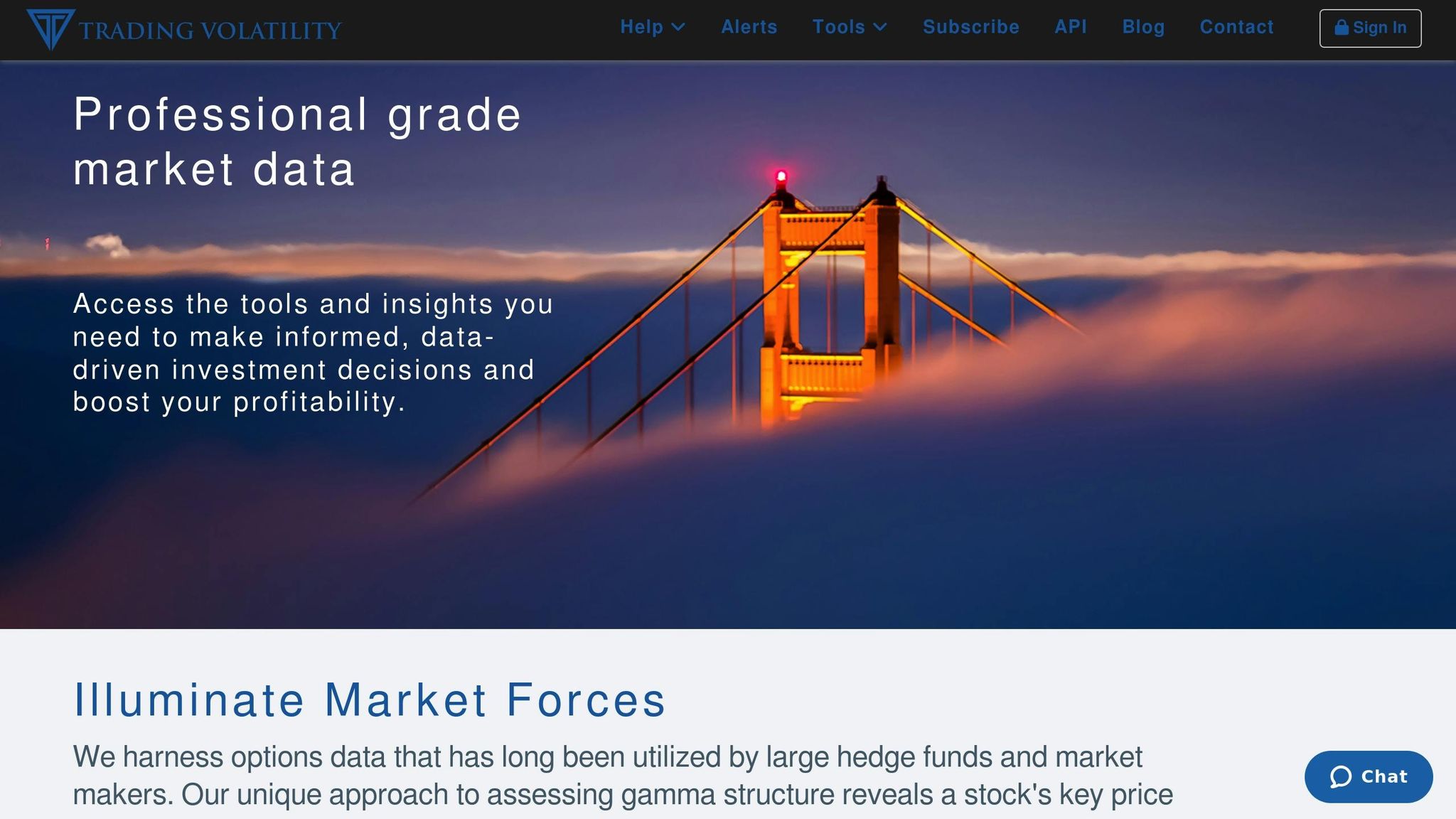
Trading Volatility offers specialized options analytics that go beyond conventional metrics. It provides unique insights like Gamma Exposure measurements, Dark Pool data, and Skew data - information that traditional market data providers typically don’t offer. These advanced tools are especially useful for traders seeking a deeper understanding of market structure and positioning.
The platform is powered by SpiderRock’s infrastructure, which integrates real-time analytics with historical data, creating a seamless link between backtesting and live execution. This setup allows users to explore key elements like asset coverage, data latency, and delivery methods with precision.
Asset Coverage
Trading Volatility supports a wide range of options markets, with a strong focus on equity options and index products. Its Gamma Exposure measurements provide insights into institutional positioning across major U.S. exchanges, while its Dark Pool data sheds light on off-exchange trading activity, which can significantly influence volatility trends.
The platform also includes Skew data, which highlights the difference in implied volatility between out-of-the-money puts and calls. This metric is essential for gauging market sentiment and identifying potential directional biases in options pricing. All these insights are delivered with a focus on low-latency performance.
Data Latency
SpiderRock’s advanced infrastructure ensures that Trading Volatility delivers data with minimal delay, catering to the needs of active traders and trading platforms. The platform’s real-time feeds provide up-to-the-minute volatility calculations, backed by efficient delivery protocols that have been rigorously tested in high-capacity trading environments.
This robust system guarantees consistent data quality and precise timing, making it a reliable choice for traders who depend on real-time analytics.
Delivery Methods
Trading Volatility offers two main delivery options through SpiderRock’s technology stack. The Real-Time Volatility API Feed (SpiderStream) provides live analytics via C# and C++, while the Live Market Data and Volatility Database offers access through WebSocket or REST APIs. These options support both real-time streaming and on-demand historical queries, catering to diverse trading needs.
Both delivery methods come with detailed API documentation, supporting multiple programming languages to simplify integration for development teams.
Cost Structure
The pricing for Trading Volatility is designed to be flexible, offering monthly licenses, yearly licenses, and usage-based plans. This allows users to select a payment model that aligns with their trading habits and data usage.
Although exact pricing details aren’t publicly available, SpiderRock’s other tools, like the Chart Tool, provide some context. For instance, Chart Tool pricing starts at $9.99 per month for basic features and goes up to $59.99 per month for trader-level access. This tiered approach suggests that Trading Volatility’s pricing is structured to accommodate both individual traders and institutional clients with varying levels of data requirements.
5. IVOlatility
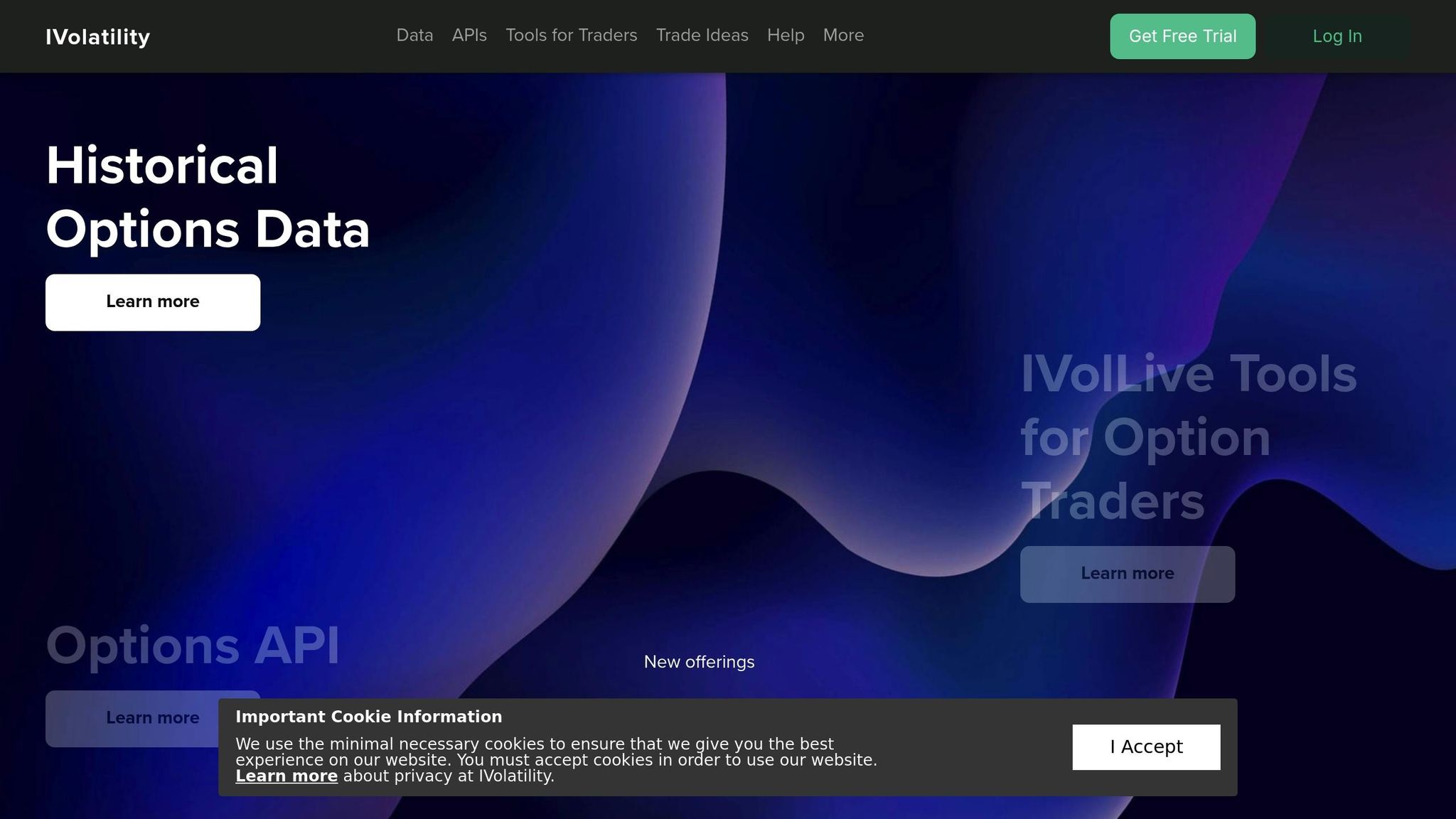
IVOlatility offers real-time volatility data across various asset classes, using a sophisticated system with over 600 filtering rules to ensure accuracy.
Asset Coverage
The platform provides data on options, futures, and more. It has moved beyond traditional equity options to include Fixed Income Reference Data for bonds worldwide and Mortgage-Backed Securities (MBS) Data Insights.
IVOlatility also tracks critical volatility metrics. For instance, it monitors the implied volatility of the S&P 500 index ($VIX) and offers access to the CBOE Skew index ($SKEW) through its IVolLive service. Additionally, its Stock Monitor tool ranks implied volatilities relative to their historical values. The platform's Vol Market Update covers implied volatilities for major indices like NDX, SPX, and DOW, as well as individual stocks. This extensive range of data is delivered in real time, ensuring users stay informed.
Data Latency
IVOlatility ensures fast and reliable data updates through its WebSocket API. This API streams options calculations and fair value pricing data derived from OPRA data, allowing users to subscribe to specific datasets. The result? Instant updates as market conditions shift, minimizing the risk of calculation errors.
Delivery Methods
The WebSocket API is the main method for delivering IVOlatility's real-time data. It enables users to subscribe to tailored data streams based on their trading or analysis needs. This setup supports high-frequency updates while maintaining the integrity of the data through rigorous filtering processes.
Platform Comparison: Pros and Cons
Each platform brings its own strengths and challenges, catering to different needs for traders and analysts.
CME Group CVOL stands out for its regulatory compliance and institutional-grade reliability. It uses a straightforward variance calculation method and updates data every 15 seconds. Plus, it adheres to EU & UK Benchmark Regulation (BMR) and IOSCO Principles, ensuring transparency and trustworthiness.
FinPricing is notable for its extensive geographic coverage, offering data from 240 countries. It also provides detailed treasury benchmarks and FX volatility data. The platform supports both API access and user-friendly graphical interfaces. Pricing information is available upon request.
OptionMetrics (IvyDB) is a go-to resource for historical data, covering 65 countries. It’s especially useful for backtesting and academic research in options markets across the U.S., Europe, and Asia. However, the cost structure might be less appealing for smaller users.
Trading Volatility specializes in tailored volatility analytics. While its pricing is also available upon request, the platform’s custom solutions might feel less accessible or clear for smaller traders who prefer straightforward options.
IVOlatility emphasizes data precision, utilizing over 600 filtering rules to ensure accuracy. Its WebSocket API enables real-time updates with minimal latency, and its coverage extends beyond equity options to include fixed income and mortgage-backed securities.
| Platform | Data Latency | Asset Coverage | Delivery Methods | Cost Structure |
|---|---|---|---|---|
| CME Group CVOL | 15-second updates | Futures across major asset classes | CME Direct, DataMine, MDP | Contact for pricing |
| FinPricing | Real-time | 240 countries, treasury & FX | APIs, GUIs | Upon request |
| OptionMetrics | Historical focus | 65 countries, options markets | Data feeds | Higher cost for smaller users |
| Trading Volatility | Real-time | Specialized volatility | Custom solutions | Upon request |
| IVOlatility | WebSocket real-time | Options, futures, fixed income, mortgage-backed securities | WebSocket API | Contact for pricing |
This table highlights the critical distinctions between platforms, offering a quick reference for comparing features.
When choosing a platform for real-time volatility tracking, it's essential to look beyond just pricing. Factors like data accuracy, update frequency, historical data availability, customer support, and integration options are equally important. While institutional users often prioritize compliance and reliability, individual traders might lean toward platforms that balance cost and ease of use.
Conclusion
Choosing the right platform for real-time volatility data boils down to your specific trading needs, budget, and technical preferences. Each platform reviewed caters to different market segments - ranging from the institutional-grade dependability of CME Group CVOL to the detailed precision offered by IVOlatility.
When evaluating platforms, look for key features like accurate and reliable data, real-time updates, historical access, advanced analytics, customization options, seamless integration, and dependable customer support. As Interactive Brokers puts it, "Volatility is a metric for the speed and movement of the underlying asset and with all things being equal such as strike price & underlying price the higher the volatility the higher the price of the option". This highlights the critical role of precise, real-time data in managing risk effectively.
The comparisons above illustrate how each platform fulfills unique demands. While individual traders may prioritize affordability and simplicity, institutional users often seek comprehensive data coverage and robust performance. For further insights, you can explore the Best Investing Tools Directory (https://bestinvestingtools.com).
Your choice today will influence your trading outcomes tomorrow. Take the time to assess your options, try platform demos, and ensure your selection aligns with your long-term trading strategy.
FAQs
What should I look for in a platform that provides real-time volatility data?
When choosing a platform for real-time volatility data, it's crucial to prioritize accurate data, reliable performance, and the ability to handle growth as your requirements expand. These elements are particularly critical for active traders and institutional investors who depend on precise, up-to-the-minute information to make informed decisions.
Look for platforms that emphasize strong security protocols to safeguard sensitive information, offer seamless integration capabilities with your existing tools, and provide responsive customer support to resolve technical issues swiftly. Focusing on these features will help create a smooth and efficient experience tailored to your trading or investment strategies.
How do delivery methods affect the accessibility and integration of real-time volatility data?
The method platforms use to provide real-time volatility data significantly impacts how easily it can be accessed and incorporated into existing systems. API-based delivery methods stand out for their efficiency, offering instant, on-demand access to live data. This allows for real-time updates and supports quicker decision-making, making it an ideal solution for dynamic environments.
In contrast, bulk delivery methods - like file transfers or scheduled batch uploads - often come with delays and can complicate integration processes. These drawbacks make them less practical for applications that rely on immediate data access. For most users, APIs remain the go-to option for ensuring quick access and seamless integration into financial systems.
How does real-time volatility data benefit institutional traders compared to individual traders?
Real-time volatility data offers institutional traders a distinct edge, enabling them to handle large and intricate portfolios with remarkable precision. This kind of data allows them to respond swiftly to market shifts, fine-tune risk management strategies, and capitalize on fleeting opportunities, all of which are crucial for staying ahead in competitive markets.
On the other hand, individual traders often face challenges due to limited access to such detailed and instant data. This lack of resources makes it harder for them to react quickly or manage sizable positions with the same level of efficiency. While real-time insights are valuable to both groups, institutional traders depend heavily on this information to execute high-frequency strategies and effectively navigate the complexities of volatile markets.
